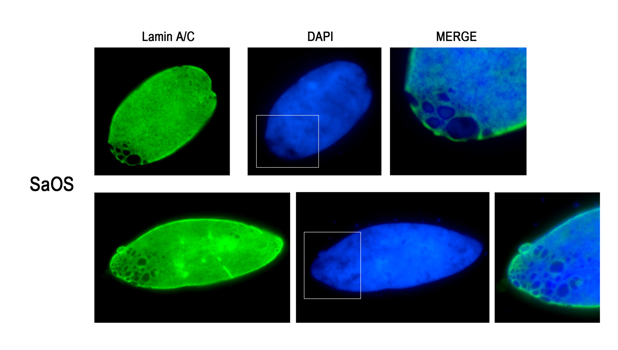Lamins in Bone Sarcomas
This project aims at investigating the functions of lamin A/C in bone sarcomas, such as osteosarcoma and Ewing sarcoma.
Lamins are the main component of nuclear lamina and are involved in a wide range of nuclear functions, including higher order genome organization, chromatin regulation, transcription, DNA replication and repair.
Alterations in lamin A/C expression correlate with malignant transformation. Altered lamin expression in tumors may in fact increase nuclear deformability, favoring the ability of cells to transit tight interstitial spaces, and promoting metastasis. Thus, lamin alterations could support tumor cells in escaping the physiological control of proliferation and cell death program.
We have shown that in osteosarcoma cells, the expression of lamin A/C is very low and this condition of low LMNA expression confers to OS cells a significant increase in migration potential, while overexpression of lamin A reduces migration ability of OS cells.
We have also evaluated lamin A/C localization and we found that lamin A/C localized at the nuclear periphery. We have shown that morphological abnormalities are present in osteosarcoma cells, and honeycomb structures, which are typical of some laminopathic cells, were detected in OS nuclei.

The identification of lamin A as a molecule potentially implicated in migration, proliferation and differentiation, in bone sarcomas, and its possible role as a biomarker, could be useful for planning new and more effective therapeutic strategies, enabling the monitoring of the disease, and predicting its possible progression in advance, with a strong translational impact.
COLLABORATIONS
Rizzoli Orthopedic Institute (IOR), Bologna
University of Bologna
University of Rome Tor Vergata
RESEARCH GROUP
Giovanna Lattanzi
Cristina Capanni
Elisabetta Mattioli
Camilla Evangelisti
Stefano Squarzoni
